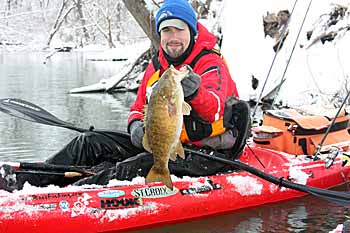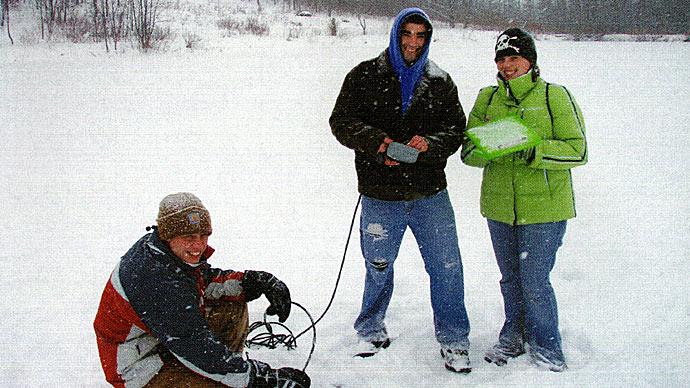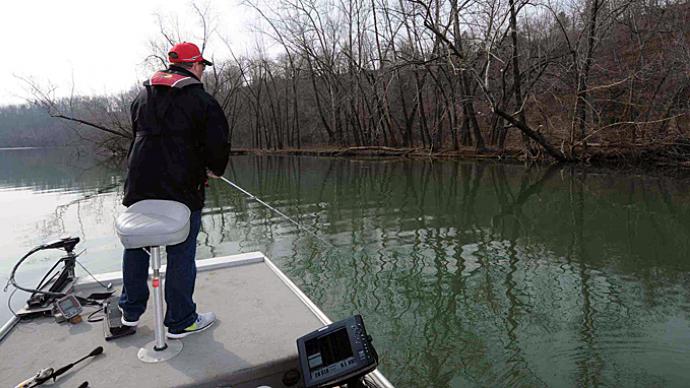
Perhaps nothing worries a northern pondmeister more than winterkill. After an unusually long winter, too many owners anxiously await ice-out to see if Mother Nature took their fish.
Winterkill involves a set of circumstances in which dissolved oxygen in water is depleted under ice during winter. In reality, winterkill actually is a result of respiration being greater than photosynthesis. Photosynthesis is the process by which green plants take sunlight as an energy source, and use it to combine carbon dioxide and water to make simple sugars. It just so happens that a by-product of this photosynthesis is oxygen. Photosynthesis is the wonderful source of energy flow for living organisms on our entire planet. Respiration is the opposite process by which animals and plants use oxygen to "burn" simple sugars in their bodies, and release energy needed for life. Carbon dioxide and water are byproducts of this process, which then can in turn be "re-used" in photosynthesis! Remember the kid-oriented movie entitled "The Lion King?" That movie revolved around a theme of "the circle of life." and there is no more basic form of the circle of life than the photosynthesis-respiration cycle on Earth.
During winter in your pond or lake, photosynthesis still occurs, but typically at a much lower rate than summer. Algae (microscopic green plants which produce much of the oxygen in your pond or lake) are still present, but typically at lower abundances than summer. So, some oxygen is still being released into the water column by plants and algae, even during cold months. Respiration of zooplankton, fish, plants, and especially bacteria that are decomposing waste products, all continue under ice.
Winterkill is more likely to occur in shallower ponds or lakes, the longer the ice cover lasts, the more snow is on top of ice, and the more productive that particular water body is. Let's take these topics one at a time.
Shallower ponds or lakes are more at risk for oxygen depletion because they contain less water volume and therefore hold less total dissolved oxygen. A deeper pond or lake has more water volume, and it takes longer for respiration of plants, animals, and bacteria to use up the available supply of dissolved oxygen in the water underneath ice.
Long periods of ice cover cause problems, of course, because the longer a pond is covered, the longer that respiration (use of oxygen) is likely occurring at a greater rate than photosynthesis (production of oxygen). So, a Kansas lake that has 6 weeks of ice cover is not nearly as vulnerable to winterkill as a Minnesota lake with ice cover from late October through early April. The Kansas pond management booklet (go to http: //www.kdwp.state.ks.us/ and search for "pond management") says that ponds in eastern Kansas should be at least 10 feet deep over one-quarter of the pond area. In contrast, the Michigan State University Extension Service web site (go to http: //www.msue.msu.edu/portal/ and again search for "pond management") suggests Michigan fish ponds and lakes be at least 12-15 feet throughout as much of the pond as possible. They continue by saying that having parts of the lake as deep as 25 feet would be even better. Depths greater than 25 feet have shown no further benefits to fish populations. So, as we move further north, more water volume is needed to help avoid winterkill.
Snow cover has considerable influence on dissolved oxygen levels. Clear ice transmits sunlight rather well, allowing photosynthesis to occur in water below. However, even a couple of inches of snow can nearly eliminate sunlight penetration into a pond or lake. This explains why some pondowners clear snow from their northern ponds during winter.
The more nutrients in a water body, the greater the biological productivity. In a pond or lake with low levels of nutrients such as phosphorus and nitrogen, there will be low levels of plant and algae biomass. However, in lakes with high levels of these nutrients, expect abundant plant and algae growth. In the fall and early winter, these plant and algae communities will die back. The more dead material sinking to the bottom, the greater the abundance of bacteria populations that will develop to feed on decaying plant material. It's a food source to them. Bacteria can use substantial amounts of dissolved oxygen (respiration) as they process dead plants. Biologists use the terms "oligotrophic" to describe nutrient-poor conditions, and "eutrophic" to describe nutrient-rich ponds and lakes. Winterkill is far more likely in a eutrophic pond or lake than in an oligotrophic one. That was the reason that I wrote the 2004 article entitled "Forget fertilizer for northern ponds." which appeared in Pond Boss Volume XII. Number 4, page 35. We don't want to artificially create eutrophic ponds at northern latitudes because of increased risk of winterkill.
I'm not sure the fisheries profession really has a complete understanding of winterkill. During bacterial decomposition of decaying material, other toxic gases are released into the pond and cannot escape into the atmosphere because of ice cover. These gases may include hydrogen sulfide (rotten-egg gas) and methane. These gases can be directly lethal to fish at sufficiently high levels, and probably help explain why winterkill is not completely predictable based only on measurements of dissolved oxygen under ice. At times, fish survive lower dissolved oxygen levels than other times, and I suspect the amount of other gases (such as hydrogen sulfide or methane) is the likely explanation. Moderately low dissolved oxygen levels may result in a fish kill when hydrogen sulfide and methane levels are high. The complicated interrelationships can be confusing.
Whew! Are you still with me? If so, let's turn to the topic of how various fishes are affected by low dissolved oxygen levels in water. Maybe this would be a good starting place: everyone "knows" that our good buddy the common carp is tolerant of low dissolved oxygen, right? Well, not so fast my friends! They actually are moderately sensitive to low dissolved oxygen.
Biologists sometimes categorize fishes into three groups when it comes to sensitivity to low dissolved oxygen.
The "sensitive" group includes most of the members of the Salmonidae family - trout and salmon. In general, this group will start to die when dissolved oxygen levels are still above 2 parts per millions.
The "intermediate" group includes fish such as walleye, white sucker, and most of the Cyprinidae family. This is the minnow family, but also includes the Asian carps such as common carp and grass carp. These fishes typically have acute lethal dissolved oxygen levels between I and 2 parts per millions. Common pond fishes such as largemouth bass and bluegill fit into this category as well.
The "tolerant" group includes fathead minnows, northern pike, and yellow perch. All these fish can survive dissolved oxygen levels below I part per million during winter. Can you believe it - our sensitive little friend the fathead minnow, so easily removed from your pond by largemouth bass predation, is one of the very "toughest" fishes there is when it comes to tolerating low dissolved oxygen levels?
One late winter day a few years ago, all the aquatic-oriented faculty members at South Dakota State University were ice fishing together. We were all using "tip-ups" with frozen smelt for bait, and were fishing for northern pike (the gator of the north). It had been a slow afternoon, meaning we hadn't caught a single fish, and it was getting toward evening. One of our faculty members had been fishing at a nearby lake, and pulled up in his jeep and asked how we were doing (yes, you southern readers, we really do drive around on the lakes when the ice is thick!) We told him we hadn't caught anything. Well, being the best scientist in the group, he actually had a dissolved oxygen meter in his jeep. He pulled it out, stuck the probe down one of my ice holes, and announced that we couldn't possibly catch a fish - he could measure NO dissolved oxygen whatsoever. We were relieved, because we "knew" it couldn't possibly be our fault we couldn't catch a fish! The sun was just about to go under the horizon at that moment, and suddenly the flag flew up on the tip-up in the hole where he had just measured zero oxygen. I pulled out a fat, healthy, 7-pound northern pike. Other flags starting flipping just then as well - the fabled sunset flurry! What about the guy with the dissolved oxygen meter? He was drilling holes as fast as he could to get his tip-ups into the water! Those northern pike are tough-very tolerant of low dissolved oxygen levels. I suspect they were feeding at sunset because predators have an advantage over prey in low-light conditions. It probably was to the pikes' advantage to use the least possible amount of energy to catch their prey when oxygen levels were so low.
| How safe is that ice? |
Ice safety should be a big concern to everyone before they venture onto the hard stuff. Following are general guidelines about how thick ice should be before it will support various loads. Proceed with caution-some of these "safe" values are not thick enough for me!
|
Reference: Barton. B.A.. and B.R. Taylor. 1996. Oxygen Requirements of Fishes in Northern Alberta Rivers with a General Review of the Adverse Effects of Low Dissolved Oxygen. Water Quality Research Journal of Canada 31(2): 361-410.
Dr. David W. Willis is a professor in the Department of Wildlife and Fisheries Sciences, South Dakota State University in Brookings. He frequents the Pond Boss forum at www.pondboss.com and can be reached there.
Reprinted with permission from Pond Boss Magazine



